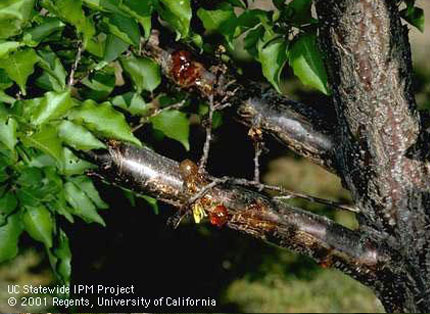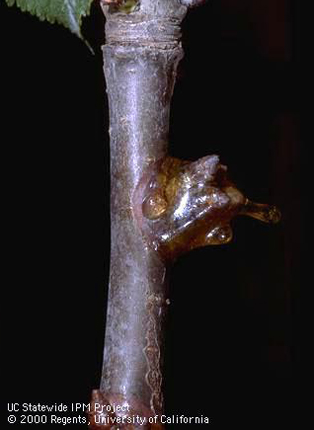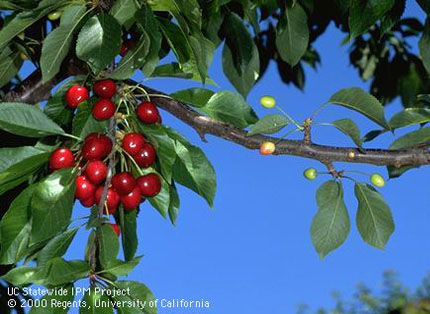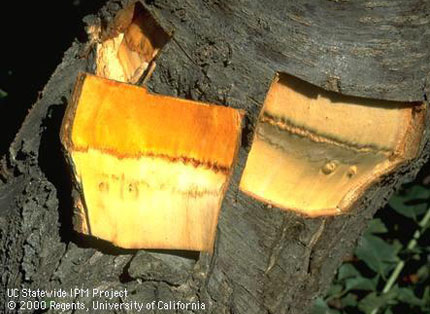The main cherry diseases in California are blossom and ripe fruit rots (caused by Monilinia fructicola and Monilinia laxa), bacterial canker (caused by Pseudomonas syringae), X-disease (caused by a phtyoplasma organism) and Phytophthora root and crown rot (caused by Phytophthora spp.).
Ripe fruit rot, brown rot blossom, and twig blight (Monilinia laxa and M. fruticola) are most prevalent with rain or dew during bloom and moderate temperatures (about 58°to 77°F; UCIPM 2013). Sweet cherry is the least susceptible of stone fruits to blossom rot and twig blight. Control is relatively simple with 1-2 fungicide sprays during bloom development; repeated applications may be necessary during frequent or heavy rain intervals, depending on the bloom stage.
Fruit rot and twig blight, also caused by Monilinia laxa and M. fruticola, occurs in both wounded and unwounded fruit. Wounding, fruit cracking and exposure to moisture increase the likelihood of infection (UC IPM 2013). Infection begins in fruit and can spread to twigs, leading to dieback and branch cankers (Brown et al., 1989). Prompt cooling and storing fruit in refrigerated conditions can help reduce postharvest losses from these diseases. Preventative sprays applied before harvest can sometimes help reduce postharvest decay (Caprile 2013). Postharvest fungicide applications applied during fruit packaging also provide good control (UC IPM 2013).
Bacterial canker (Pseudomonas syringae) occurs under cold, wet conditions in trees that are stressed due to low nutrient availability, nematode feeding, poor soil, or mismanaged irrigation. Bacterial canker can affect trees of any age, but is usually most severe in young orchards from 1 to 6 years old (UC IPM 2013). Cankers produced by the bacteria girdle and kill individual branches and sometimes entire trees (Brown et al., 1989).
X-disease is spread through vector pests (e.g. Cherry and Mountain leafhoppers) leading to tree decline and death in areas north of Madera, California (UC IPM 2013). Symptoms differ among rootstocks (Brown et al., 1989). Prompt removal of infected trees, combined with regular postharvest orchard treatments using effective insecticides, can help prevent the spread of X-disease within and among orchards (UC IPM 2013).
Phytophthora root and crown rot typically occur in over irrigated soils. To prevent Phythophthora infection, maintain good soil drainage and irrigate so as to avoid prolonged periods of saturated soil conditions (UC IPM 2013). Planting trees on berms can also improve drainage around the crown of the tree (below-ground part of the trunk) and reduce disease incidence (Day 2003).
Cherry Photo Gallery
These photos are accessed from the UC ANR Repository, are available courtesy of University of California research and extension personnel and programs, including the UC Statewide IPM Project.

|

|

|
| Brown rot blossom infections. | Evidence of bacterial canker. | Gum-covered bud killed by bacterial canker (blast). |
| Photo by JK Clark. UC IPM Project © UC Regents. | Photo by JK Clark. UC IPM Project © UC Regents. | Photo by JK Clark. UC IPM Project © UC Regents. |

|

|
|
| Healthy fruit & fruit with X-disease symptoms (cherry buckskin). | Trunk damaged by X-disease (cherry buckskin) | |
| Photo by JK Clark. UC IPM Project © UC Regents. | Photo by JK Clark. UC IPM Project © UC Regents. |
